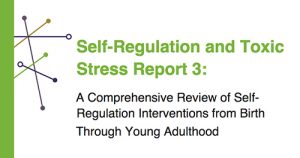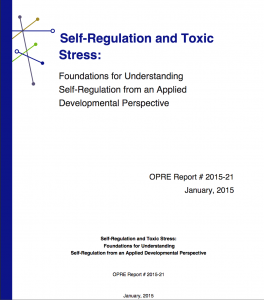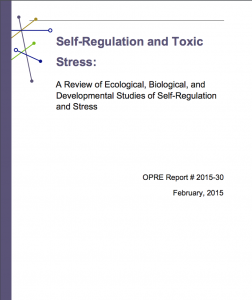Aleta L. Meyer is Senior Social Science Research Analyst, Office of Planning, Research and Evaluation Administration for Children and Families, U.S. Department of Health and Human Services. Meyer’s work focuses on the translation of theory and empirical research across multiple health outcomes into effective and feasible prevention programs for communities. At Administration for Children and Families (ACF) this includes the translation of research on early adversity to ACF programs, community-based-participatory-research to evaluate early childhood programs within American Indian/Alaska Native communities, and positive youth development.
In March 2015 we featured the first of 4 inter-related reports on self-regulation and toxic stress published by the Duke Center for Child and Family Policy, titled Seven Key Principles Identified in New Report on Self-Regulation Development, by Meyer who conceived the project, led the effort, and is the project’s program officer.
Since that time, the project published a second report, A Review of Ecological, Biological, and Developmental Studies of Self-Regulation and Stress, a literature review on the impact of early adversity and chronic stress on self-regulation development from birth to young adulthood.
This post by Meyer, highlights the recently released 3rd report, Self-Regulation and Toxic Stress Report 3: A Comprehensive Review of Self-Regulation Interventions from Birth Through Young Adulthood. Key authors: Desiree W. Murray, Katie  Rosanbalm, Christina Christopoulos, Center for Child and Family Policy, Duke University.
Rosanbalm, Christina Christopoulos, Center for Child and Family Policy, Duke University.
While the majority of scientific and public attention has been focused on self-regulation during early childhood, some experts are paying increasing attention to the role of self-regulation during adolescence. Given the potential for understanding why some individuals beat the odds, adapt, and thrive in the face of adversity, The Office of Planning Research and Evaluation (OPRE) within the Administration for Children and Families (ACF) funded a team led by Dr. Desiree Murray at the Center for Child and Family Policy at Duke to articulate a continuous story of the development of self-regulation, from birth to young adulthood, across four inter-related reports in a series titled Self-Regulation and Toxic Stress.
OPRE’s third report in this series was published recently: Self-Regulation and Toxic Stress Report 3: A Comprehensive Review of Self-Regulation Interventions from Birth Through Young Adulthood. It describes results of a comprehensive review of self-regulation interventions from birth through young adulthood and summarizes the level of evidence for different age groups and outcome domains. Importantly, there were significant gaps between the types of interventions being studied and those that would be recommended based upon the theoretical model of self-regulation development provided in the first report. For example, limited attention was given to emotion regulation or its integration with cognitive regulation in early to mid-adolescence, when neurobiological changes may make emotion regulation a greater challenge.
Unfortunately, this limited attention in the intervention research literature reflects the public story of self-regulation in adolescence, a story which is fraught with negative perceptions and portrayals that serve to depress public support for interventions designed to improve developmental outcomes during this timeframe. A corresponding brief to this series, created by the Frameworks Institute, describes communication strategies for navigating unproductive patterns of public understanding that are likely to get in the way of science messages about self-regulation in adolescence.
From the brief ( Abigail Haydon, PhD, Fellow, Nat Kendall-Taylor, PhD, Vice President of Research): The work reviews and synthesizes over 12 years of research conducted by the FrameWorks Institute in order to present the challenges — and potential
solutions — surrounding scientific communication about self-regulation during adolescence, with a particular focus on the role of interventions in strengthening self-regulation capacities. The challenges associated with communicating about these topics are substantial. In order to navigate unproductive patterns of public understanding that are likely to get in the way of science messages, authors offer recommendations for communicators. See the full report: Communicating Scientific Findings About Adolescence and Self-Regulation: Challenges and Opportunities.
Stay tuned for the upcoming fourth report in this series, Implications for Programs and Practice, which will provide an applied summary of the results of Report 3 organized by their implications for ACF programs that serve children, youth and families, from birth to young adulthood. Additionally, resources comprised of shorter briefs and fact sheets focused on specific age groups and populations are being created.
Aleta Meyer is Acting Division Director, Team Leader for American Indian and Alaskan Native Research/Senior Social Science Research Analyst at OPRE. From 2007-2010, she was a health scientist administrator in the Prevention Research Branch at the National Institute on Drug Abuse (NIDA). Prior to joining NIDA, she was an Associate Professor of Psychology in the Clark-Hill Institute for Positive Youth Development at Virginia Commonwealth University. She completed her doctoral work in Human Development and Family Studies at The Pennsylvania State University, with an emphasis in Prevention Science.


